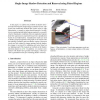108
click to vote
CVPR
2011
IEEE
14 years 8 months ago
2011
IEEE
We characterize a class of videos consisting of very small but potentially complicated motions. We find that in these scenes, linear appearance variations have a direct relations...
196
click to vote
CVPR
2011
IEEE
14 years 8 months ago
2011
IEEE
We propose a new method to quickly and accurately predict 3D positions of body joints from a single depth image, using no temporal information. We take an object recognition appro...
151
click to vote
CVPR
2011
IEEE
14 years 8 months ago
2011
IEEE
Exact recovery from contaminated visual data plays an important role in various tasks. By assuming the observed data matrix as the addition of a low-rank matrix and a sparse matri...
289
Voted
CVPR
2011
IEEE
14 years 8 months ago
2011
IEEE
This paper addresses the problem of simultaneous tracking of multiple targets in a video. We first apply object detectors to every video frame. Pairs of detection responses from ...
133
Voted
CVPR
2011
IEEE
14 years 8 months ago
2011
IEEE
We propose a new learning method which exploits temporal consistency to successfully learn a complex appearance model from a sparsely labeled training video. Our approach consists...
171
Voted
CVPR
2011
IEEE
14 years 8 months ago
2011
IEEE
We propose a new family of non-submodular global energy functions that still use submodularity internally to couple edges in a graph cut. We show it is possible to develop an ef�...
143
Voted
CVPR
2011
IEEE
14 years 8 months ago
2011
IEEE
Recent work in structure from motion (SfM) has successfully built 3D models from large unstructured collections of images downloaded from the Internet. Most approaches use increme...
143
Voted
CVPR
2011
IEEE
14 years 8 months ago
2011
IEEE
In real-world applications, “what you saw” during training is often not “what you get” during deployment: the distribution and even the type and dimensionality of features...
136
click to vote
CVPR
2011
IEEE
14 years 8 months ago
2011
IEEE
In this paper we introduce visual phrases, complex visual composites like “a person riding a horse”. Visual phrases often display significantly reduced visual complexity comp...
131
Voted
CVPR
2011
IEEE
14 years 8 months ago
2011
IEEE
In this paper, we address the problem of shadow detection and removal from single images of natural scenes. Different from traditional methods that explore pixel or edge informati...






